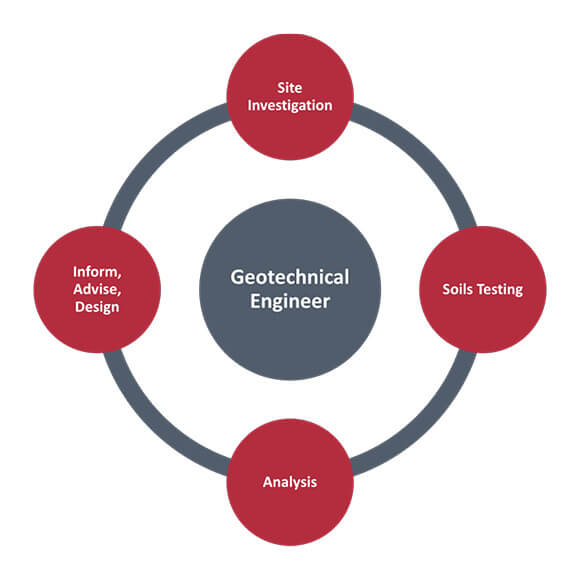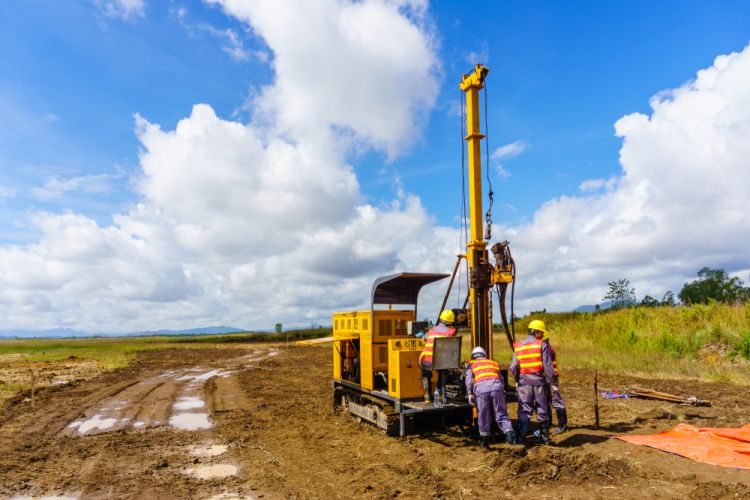The smart Trick of Geotechnical Engineering For Construction Projects That Nobody is Talking About
Geotechnical Engineering For Construction Projects Fundamentals Explained
Table of ContentsThe Main Principles Of Geotechnical Engineering For Construction Projects Geotechnical Engineering For Construction Projects for DummiesGeotechnical Engineering For Construction Projects for DummiesA Biased View of Geotechnical Engineering For Construction ProjectsThe Ultimate Guide To Geotechnical Engineering For Construction ProjectsThe Basic Principles Of Geotechnical Engineering For Construction Projects The Main Principles Of Geotechnical Engineering For Construction Projects
and Kovacs, W. (1981 ), An Intro to Geotechnical Engineering, Prentice-Hall, Inc. Deep Scan Tech (2023 ): Deep Check Tech uncovers surprise structures at the site of Denmark's highest structure. "Geofrost Coring". GEOFROST. Recovered 20 November 2020. Han, Jie (2015 ). Concepts and Practice of Ground Improvement. Wiley. ISBN 9781118421307. RAJU, V. R.Ground Renovation Technologies and Case Histories. Singapore: Study Publishing Services. p. 809. ISBN978-981-08-3124-0. Ground Improvement Concepts And Applications In Asia. Pariseau, William G. (2011 ). Design evaluation in rock technicians. CRC Press. Hegde, A.M. and Palsule P (Geotechnical Engineering for Construction Projects).S. (2020 ), Efficiency of Geosynthetics Reinforced Subgrade Subjected to Repetitive Vehicle Loads: Experimental and Numerical Studies.
Cengage Knowing, Stamford, 666 p. Atkinson, J., 2007. The technicians of dirts and structures. The Observational Method in ground design principles and applications.
Some Known Facts About Geotechnical Engineering For Construction Projects.
Research laboratory and area testing plays a vital function in this procedure. By extracting examples from the planet's subsurface and using a suite of examinations, geotechnical engineers can predict the behavior of soil layers and examine their viability for different building and construction endeavours. The essence of geotechnical engineering in civil design can not be overemphasized, attributable to a number of variables: The first step in any geotechnical research study involves establishing the soil kind at the building site.
Comprehending these qualities guarantees that only appropriate dirt kinds are picked for the growth, therefore averting possible structural failures. The foundation functions as the bedrock of any kind of construction job. Choosing the suitable structure kind is a decision that pivots on the detailed analysis provided by geotechnical design. This makes sure the longevity and security of frameworks by suiting the lots they will birth.

Geotechnical website examination is a vital action in the planning and implementation of any type of construction job. It entails the collection and evaluation of data connected to the physical buildings of soil and rock underneath a proposed building site. This information is crucial for the style and building of secure, steady, and sustainable frameworks.
Geotechnical Engineering For Construction Projects - Truths
, additionally understood as subsurface expedition, includes a series of activities aimed at identifying the dirt, rock, and groundwater problems at a construction site. The key objectives are to recognize prospective geotechnical risks, evaluate the engineering buildings of subsurface products, and provide suggestions for the design and building of foundations, keeping walls, and other frameworks.
The desk research study assists in determining possible geotechnical problems and planning the succeeding fieldwork. This includes observing the topography, water drainage patterns, existing structures, plants, and any indications of instability or disintegration.
The Definitive Guide to Geotechnical Engineering For Construction Projects
Shallow test pits are dug deep into to straight observe and example the dirt and rock. This method is useful for researching the top layers of the subsurface and identifying near-surface risks. Non-invasive geophysical techniques, such as seismic refraction, ground-penetrating radar (GPR), and electrical discover this resistivity tomography (ERT), are used to map subsurface problems and spot abnormalities.
Dirt and rock samples accumulated during the area examination undergo research laboratory testing to determine their physical and mechanical homes. Usual research laboratory tests consist of grain dimension analysis, Atterberg limitations, compaction tests, triaxial shear examinations, and debt consolidation examinations. These tests supply important data for geotechnical analysis and design. The information collected from the desk study, website reconnaissance, area investigation, and lab screening are analyzed and interpreted to create a thorough understanding of the subsurface conditions.
The key benefit of geotechnical site investigation is making certain the safety and security and security of frameworks. By comprehending the subsurface conditions, designers can make foundations and other architectural components that can withstand the tons and ecological forces they will certainly undergo. This minimizes the threat of negotiation, subsidence, and architectural failure.
Geotechnical Engineering For Construction Projects Can Be Fun For Anyone
Comprehending soil attributes can direct the choice of excavation strategies, dewatering techniques, and ground improvement actions. This guarantees effective and secure building and construction techniques. Geotechnical website investigations are typically required by building codes and guidelines. Complying with these needs ensures compliance with legal and security criteria, avoiding possible lawful liabilities and job delays.
This information is vital for job supervisors, engineers, and specialists in creating practical routines, spending plans, and contingency plans. Geotechnical Engineering for Construction Projects. Skyscraper Building in a Coastal AreaIn a coastal city, a high-rise domestic structure was intended on a website with thought loose sand deposits and a high water table. A thorough geotechnical examination, consisting of borehole boring, CPT, and geophysical studies, was carried out
Fascination About Geotechnical Engineering For Construction Projects
Based on these searchings for, the foundation style was modified to include deep heap foundations extending into secure strata, and ground enhancement strategies, such as vibro-compaction, were applied to reduce click to investigate liquefaction threats. This proactive approach guaranteed the safety and stability of the building while avoiding expensive post-construction removal. Facilities Development on a Sloping TerrainA major infrastructure task, involving the building of a highway and bridges, was intended on an uneven terrain with steep slopes.

The Leaning Tower of Pisa (Italy), a renowned building wonder, is notorious for its unexpected tilt from substantial geotechnical problems. The tower's structure was improperly created to handle the soft, unstable soil below it, leading to irregular negotiation and its distinct lean. Our globe is dotted with outstanding facilities projectsfrom looming skyscrapers to sprawling bridgesall standing statement to the development of the various building devices and approaches available.
Geotechnical engineering is a specialized field within civil engineering that concentrates on studying the habits of planet products. This branch dives deep right into the groundinvestigating exactly how the dirt, rock, and groundwater at a construction site can influenceand be affected bythe infrastructure that we erect on and right into them. Before a solitary block is laid or a concrete structure poured, geotechnical engineers probe right into the earthgathering important information about the website's soil structure, rock framework, and groundwater levels.
Getting The Geotechnical Engineering For Construction Projects To Work

is a device made use of to evaluate the integrity and load-bearing capability of piles throughout installment, leveraging the concept of wave breeding. It enhances building and construction effectiveness by giving real-time examinations, thus ensuring risk-free and reliable stack structures. One of the sensible applications of geotechnical design involves making a decision and implementing the best approaches for structure building and useful link construction.
Stack driving stands for greater than the mere act of inserting structural elements into the ground. On the other hand, it is a thoroughly managed process of moving a structure's lots past the less secure dirt layers better to the surfacedown to the extra significant strata that exist under. When it comes to heap driving, take into consideration how geotechnical engineers expertly utilize this method to uniformly disperse the structure's weight.